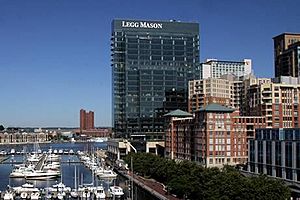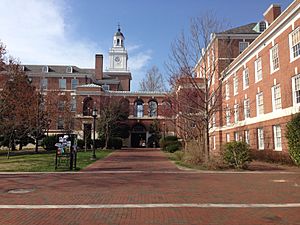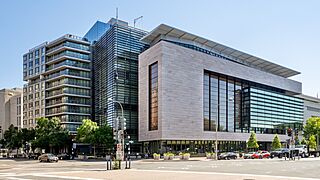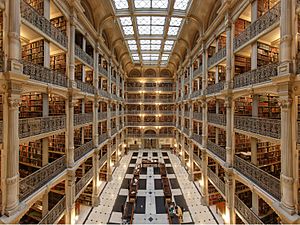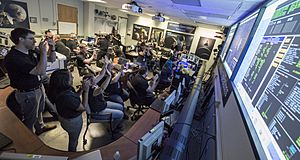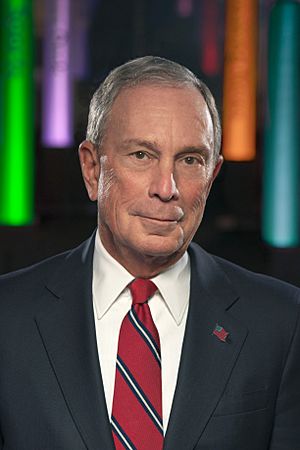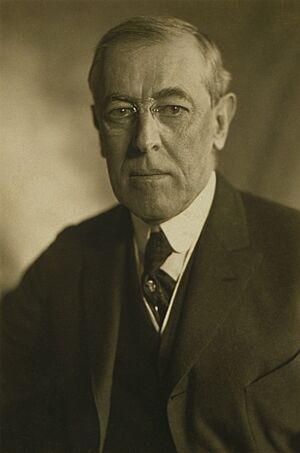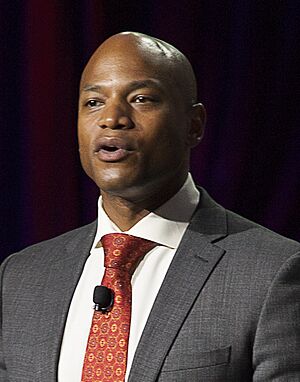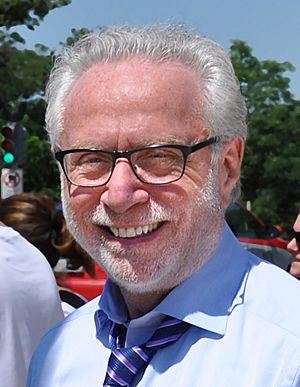Johns Hopkins University facts for kids
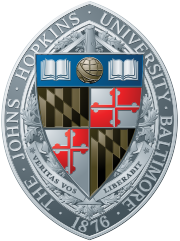 |
|
| Latin: Universitas Hopkinsiensis | |
| Motto | Veritas vos liberabit (Latin) |
|---|---|
|
Motto in English
|
"The truth will set you free" |
| Type | Private research university |
| Established | February 22, 1876 |
| Accreditation | MSCHE |
|
Academic affiliations
|
|
| Endowment | $13.06 billion (FY2024) |
| President | Ronald J. Daniels |
| Provost | Ray Jayawardhana |
|
Total staff
|
27,300 |
| Students | 30,549 (2022) |
| Undergraduates | 5,318 (2022) |
| Postgraduates | 25,231 (2022) |
| Location |
,
,
United States
39°19′44″N 76°37′13″W / 39.32889°N 76.62028°W |
| Campus | Large city, 140 acres (57 ha) |
| Other campuses | |
| Newspaper | The Johns Hopkins News-Letter |
| Colors | Heritage blue and spirit blue |
| Nickname | Blue Jays |
|
Sporting affiliations
|
|
| Mascot | Blue Jay |
Johns Hopkins University (often called Johns Hopkins, Hopkins, or JHU) is a private research university in Baltimore, Maryland, United States. It was started in 1876. Johns Hopkins is known as the first research university in the U.S. It was built on a model from European research schools.
The university is named after its first supporter, Johns Hopkins. He was an American businessman and a Quaker who gave away a lot of money. His gift of $7 million (which was a huge amount back then) helped start the university. Daniel Coit Gilman became the first president of Johns Hopkins on February 22, 1876. He changed higher education in the U.S. by mixing teaching with research. Johns Hopkins has been a leader in research and development spending among U.S. universities for over 40 years. The School of Medicine, started in 1893, is famous for its new medical research.
The university has ten main academic parts. Most are on four campuses in Baltimore. Some graduate campuses are in Italy, China, and Washington, D.C.. The two undergraduate schools, the Zanvyl Krieger School of Arts and Sciences and the Whiting School of Engineering, are on the Homewood campus in Baltimore. The medical campus in East Baltimore has the School of Medicine, School of Nursing, and Bloomberg School of Public Health. These are next to the Johns Hopkins Hospital. Other parts of the university include the Peabody Institute, Applied Physics Laboratory, School of Advanced International Studies, School of Education, and Carey Business School.
The Blue Jays men's lacrosse team started in 1883. They have won 44 national titles. The university's other sports teams play in Division III of the NCAA. They are part of the Centennial Conference.
History of Johns Hopkins University
How Johns Hopkins University Started
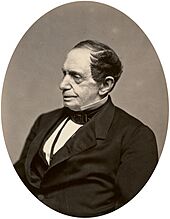

When Johns Hopkins died in 1873, he left $7 million to start a hospital and a university in Baltimore. This was the biggest gift ever given to charity in the U.S. at that time. Most of this money came from the Baltimore and Ohio Railroad.
For a long time, people thought Johns Hopkins was against slavery. But recent research into old records showed he owned slaves in the 1840s and 1850s.
The university's first leaders wanted a new kind of university. It would focus on discovering new knowledge at a high level. They looked at the German education model, especially Heidelberg University, for ideas. Johns Hopkins became the example for modern research universities in the United States. Its success changed U.S. higher education. It went from just teaching what was already known to finding new scientific knowledge.
The 19th Century at Hopkins

The university's leaders chose Daniel Coit Gilman to be the first president. Gilman was a scholar from Yale University. He had been president of the University of California, Berkeley. Before starting at Hopkins, Gilman visited German universities to learn from them.
Gilman had a bold idea: to combine teaching and research. He believed that the best teachers were also good at doing their own research. He hired famous researchers from around the world. These included mathematician James Joseph Sylvester and physicist Henry Augustus Rowland.
Gilman focused on growing graduate education and supporting professors' research. The new university mixed advanced studies with professional schools like medicine and engineering. Hopkins became a leader in doctoral programs. It also hosted many scholarly journals. The Johns Hopkins University Press, started in 1878, is the oldest American university press that has been open continuously.
The Johns Hopkins Hospital opened in 1889, and the medical school opened in 1893. These attracted famous doctors and researchers. The medical school made history by being the first to let women in as students, equally with men. It also required students to have a Bachelor's degree. This happened because of Mary E. Garrett, who helped fund the school. The medical school became a model for teaching medicine. It focused on learning at the patient's bedside, research, and lab training.
Johns Hopkins had wanted the university to be built on his large estate, Clifton. But President Gilman decided to use the money to hire great teachers and students instead of building. He wanted to "build men, not buildings." Also, the money from the Baltimore and Ohio Railroad became almost worthless. So, the university's first home was in Downtown Baltimore.
The 20th Century at Hopkins
In the early 1900s, the university needed more space. They found a new home in north Baltimore called the Homewood Estate. This land was given to the university on February 22, 1902. The main building, Gilman Hall, was finished in 1915. The School of Engineering moved there in 1914, and the Zanvyl Krieger School of Arts and Sciences followed in 1916. The university also gave land for Wyman Park and the Baltimore Museum of Art. The campus is now about 140 acres.
The Homewood estate was originally a gift from Charles Carroll of Carrollton, Maryland. He was a signer of the Declaration of Independence. The old house from 1801, Homewood House, is still there and is a museum. Its Federal style inspired the design of many university buildings.
In 1909, Johns Hopkins was one of the first to start programs for adults who wanted to keep learning. In 1916, it started the nation's first school of public health.
Since 1942, the Johns Hopkins Applied Physics Laboratory (APL) has worked on defense projects for the government. Johns Hopkins has received the most federal research funding of any American university every year since 1979.
New schools for international affairs and music were added in 1950 and 1977. These were the School of Advanced International Studies in Washington, D.C., and the Peabody Institute in Baltimore.
The 21st Century at Hopkins
The early 2000s saw the university grow in size and student numbers. The medical campus started an 88-acre expansion in 2013. The Homewood campus added a new biomedical engineering building, a new library, and a renovated Gilman Hall.
The university's business and education schools also grew quickly. In 2007, the Johns Hopkins School of Education and the Carey Business School became separate schools.
On November 18, 2018, Michael Bloomberg gave $1.8 billion to his old school. This was the largest private gift ever to a higher education school. It brought his total gifts to over $3.3 billion. This gift helps the school offer need-blind admission. This means they admit students based on their abilities, not how much money their family has. They also meet all financial needs for admitted students.
In January 2019, the university bought the Newseum building in Washington, D.C.. They plan to move all their D.C. graduate programs there. This helps the university share its knowledge in national and international policy talks.
In late 2019, the university's Coronavirus Research Center started tracking worldwide cases of the COVID-19 pandemic. They gathered data from many sources. This made the university a key source for information about the pandemic.
In February 2025, the university was part of a government investigation into concerns about certain issues on college campuses.
Johns Hopkins Police Department
In February 2019, Johns Hopkins University asked to create its own police force. This force would patrol around its three Baltimore campuses. Some local communities, students, and professors were against this idea. A law was passed in April 2019 allowing Johns Hopkins to create a private police department.
After the events of May 2020, many people asked the university president to rethink the police department plan. In June 2020, the president announced they would pause the plan for at least two years. However, in the summer of 2021, Dr. Branville Bard Jr. was hired as the new vice president for public safety.
The law requires the university to have a civilian board to oversee the police. It also needs an agreement with the Baltimore Police Department. A draft of this agreement was shared in September 2022. Community members still had concerns. Despite ongoing protests, officer hiring and training began in spring 2024. Officers started active duty in summer 2024.
Civil Rights at Hopkins
African-Americans
Johns Hopkins was a supporter of ending slavery. After his death, it was said that his beliefs helped the university admit its first African-American student, Kelly Miller. He was a graduate student in physics, astronomy, and math. Later, the university had a "separate but equal" policy, like other Baltimore schools.
The first black undergraduate student came to the school in 1945. Graduate students followed in 1967. Vivien Thomas, an African-American instructor, helped develop the first successful "blue baby operation" in 1944. However, more racial diversity at Johns Hopkins did not become common until the 1960s and 1970s.
Women
A big step for women's rights at Hopkins was led by the daughters of university trustees. These included Mary E. Garrett, M. Carey Thomas, Mamie Gwinn, Elizabeth King, and Julia Rogers. They raised money to open the medical school. They made sure that women would be admitted equally with men. The nursing school opened in 1889 and accepted both women and men. Other graduate schools opened to women in 1907. Christine Ladd-Franklin was the first woman to earn a PhD at Hopkins in 1882, but she was not given the degree for many years. In 1893, Florence Bascomb became the university's first female PhD. The decision to admit women at the undergraduate level was made in October 1969. As of 2020, 53% of undergraduate students were female.
Freedom of Speech
On September 5, 2013, Johns Hopkins professor Matthew D. Green wrote a blog post about the NSA. He was asked to take it down because it linked to sensitive material. The links were to news articles that were already public. The dean later apologized. This event raised questions about academic freedom of speech.
Campuses and Schools
| Main Campuses & Schools | ||||||||||
|---|---|---|---|---|---|---|---|---|---|---|
| Homewood Campus | East Baltimore Campus (Medical Institutions) |
Downtown Baltimore Campus | Washington, D.C. Campus | Laurel, Maryland Campus | ||||||
| School of Arts and Sciences 1876 |
School of Education 1909 |
School of Engineering 1913 |
School of Nursing 1889 |
School of Medicine 1893 |
School of Public Health 1916 |
Peabody Institute 1857 |
School of Business 2007 |
School of Advanced International Studies 1943 |
Applied Physics Laboratory 1942 |
|
Homewood Campus
The Homewood Campus is where most undergraduate programs are located. The buildings are designed in the Federal style, inspired by the historic Homewood House on campus.
- Whiting School of Engineering: This school has many engineering programs for both undergraduate and graduate students.
- Zanvyl Krieger School of Arts and Sciences: This school offers over 60 majors and minors for undergraduates and more than 40 graduate programs.
The School of Education is also located near the Homewood Campus.
East Baltimore Campus
This campus is known as the Johns Hopkins Medical Institutions (JHMI). It includes:
- Johns Hopkins Bloomberg School of Public Health: Started in 1916, it is the world's oldest and largest public health school. It is often ranked number one in its field.
- School of Medicine: This school is considered one of the best medical schools and research centers in the world.
- School of Nursing: This is one of America's oldest and top schools for nursing education. It is often ranked number one nationally.
Mount Vernon Campus
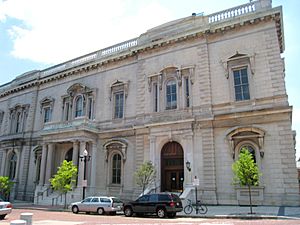
- Peabody Institute: Founded in 1857, it is the oldest music conservatory in the U.S. It became part of Johns Hopkins in 1977. Students from both Hopkins and Peabody can take classes at either school.
Harbor East Campus
- Carey Business School: This school started in 2007. It moved to the Legg Mason building in Harbor East in 2011.
Washington, D.C. Campus
In 2019, Hopkins bought the former Newseum building in Washington, D.C.. This building, now called the Johns Hopkins University Bloomberg Center, opened in 2023. It houses several university divisions.
- School of Advanced International Studies (SAIS): This school is located in the Hopkins Bloomberg Center. It is ranked as one of the best master's degree programs in international relations.
The Bloomberg Center also hosts programs from the Carey School of Business, Krieger School of Arts and Sciences, and Peabody Institute.
-
The Hopkins Bloomberg Center (Previously the Newseum)
Laurel, Maryland Campus
The Applied Physics Laboratory (APL) in Laurel, Maryland, does research for the U.S. government, including Department of Defense and NASA. It has designed spacecraft for NASA and developed many medical devices. APL is also a main campus for master's degrees in science, technology, engineering, and math (STEM) fields.
Other Campuses Around the World
Johns Hopkins also has campuses in other locations:
- Domestic:
* Columbia, Maryland: Has branches of the Carey Business School and School of Education. * Montgomery County, Maryland: Offers part-time programs in biosciences, engineering, business, and education.
- International:
* Hopkins–Nanjing Center in Nanjing, China. * SAIS Europe in Bologna, Italy, which is the European campus for the SAIS.
How Johns Hopkins is Organized
Johns Hopkins is made up of two main parts: the university and The Johns Hopkins Health System. The university president is the main leader. The university has nine academic divisions.
The university has a board of trustees with 18 to 65 voting members. They serve six-year terms. Students, faculty, or staff cannot be on the board, except for the president. The Johns Hopkins Health System has its own board, often with doctors and healthcare leaders.
Academics and Learning
The four-year undergraduate program at Johns Hopkins is very selective. It has a low number of transfer students and many graduate students. The Princeton Review rates Johns Hopkins as 99/99 for selectivity. As of 2025, the cost to attend for one year without financial help is about $89,000. However, 51% of full-time undergraduate students receive financial aid that covers all their needs. About 80% of Hopkins undergraduates are accepted into medical school, and 97% are accepted into law school. These are some of the highest rates in the U.S. The university is a founding member of the Association of American Universities (AAU).
University Rankings
| ARWU World | 17 |
|---|---|
| THES World | 16 |
| USNWR National University | 6 (tie) |
| Washington Monthly National University | 14 |
| Forbes | 12 |
As of 2024–25, U.S. News & World Report ranked Johns Hopkins University as the 6th best university in the nation (tied) and 13th best globally.
| Institution | Specialization | US Rank | Site |
|---|---|---|---|
| Johns Hopkins University | Overall | 6 (tie) | U.S. News & World Report |
| Johns Hopkins University | Pre-med | 2 | Prepscholar, Medicalaid (2021) |
| Zanvyl Krieger School of Arts and Sciences | Neuroscience / Neurobiology | 4 (tie) | U.S. News & World Report |
| Zanvyl Krieger School of Arts and Sciences | Molecular Biology | 3 (tie) | U.S. News & World Report |
| Zanvyl Krieger School of Arts and Sciences | Physics | 13 (tie) | U.S. News & World Report |
| Whiting School of Engineering | Biomedical Engineering | 1 (tie) | U.S. News & World Report |
| Whiting School of Engineering | Computer Science | 21 | U.S. News & World Report |
| Whiting School of Engineering | Undergraduate Engineering | 13 (tie) | U.S. News & World Report |
| Johns Hopkins School of Medicine | Medicine (Research) | 2 | U.S. News & World Report |
| Johns Hopkins Bloomberg School of Public Health | Public Health | 1 | U.S. News & World Report |
| Johns Hopkins Bloomberg School of Public Health | Biostatistics | 1 (tie) | U.S. News & World Report |
| Johns Hopkins University School of Nursing | Nursing (Master's) | 2 | U.S. News & World Report |
| Johns Hopkins University School of Nursing | Doctor of Nursing Practice | 1 | U.S. News & World Report |
| Peabody Institute | Music | 5 | Niche (2024) |
Applying to Johns Hopkins
| Johns Hopkins University | |
|---|---|
| Class of 2028 Applicants | 45,134 |
| Class of 2028 Admitted (n, %) | 2,558, 5.67% |
| SAT Range (middle 50th percentile, 2028 data) | 1530–1570 |
| ACT Range (middle 50th percentile, 2028 data) | 34–36 |
Getting into Johns Hopkins as an undergraduate is very competitive. In 2021, about 6.4% of all applicants were accepted. In 2022, 99% of accepted students were in the top 10% of their high school class. The number of applications has grown, making it harder to get in.
Students can apply through Early Decision I or II if Hopkins is their top choice. If accepted, they must enroll. The Regular Decision application is not binding. The application fee is $70, but fee waivers are available. Johns Hopkins does not give special preference to students whose family members also attended. The university practices need-blind admission, meaning they admit students without looking at their ability to pay. They also meet the full financial need of all admitted students.
| Year | Applicants | Growth | Acceptance rate | Accepted | Enrolled | Yield |
|---|---|---|---|---|---|---|
| 2024 | 45,134 | +17.9% | 5.7% | 2,558 | 1,288 | 50% |
| 2023 | 38,294 | +3.1% | 6.3% | 2,403 | 1,306 | 54% |
| 2022 | 37,156 | -4.0% | 6.5% | 2,407 | 1,310 | 54% |
| 2021 | 38,725 | +30.8% | 6.4% | 2,476 | 1,336 | 54% |
| 2020 | 29,612 | -8.1% | 8.8% | 2,604 | 1,300 | 50% |
Libraries at Johns Hopkins
The Johns Hopkins University Library system has over 3.6 million books. It has ten main parts across the university's campuses. The biggest part is the Sheridan Libraries. This includes the Milton S. Eisenhower Library (the main library on the Homewood campus), the Brody Learning Commons, and the George Peabody Library.
The main library is named after Milton S. Eisenhower, a former university president. Only two of its six floors are above ground. This is because of a campus story that no building should be taller than Gilman Hall. A four-story addition, the Brody Learning Commons, opened in 2012. It has modern technology and study spaces.
Johns Hopkins University Press
The Johns Hopkins University Press is the university's publishing company. It started in 1878. It is the oldest continuously running university press in the United States. It has published over 6,000 books and publishes 65 scholarly magazines each year. Since 1993, it has run Project MUSE, an online collection of academic journals.
Center for Talented Youth
The Johns Hopkins University also runs the Center for Talented Youth (CTY). This program helps find and develop the talents of bright students from kindergarten to 12th grade around the world. CTY helps the university prepare students to make important contributions in the future.
Degrees Offered
Johns Hopkins offers many different degrees. Undergraduate students can earn Bachelor of Arts (BA) and Bachelor of Science (BS) degrees. Graduate students can earn Master of Arts (MA), Master of Science (MS), and Doctor of Philosophy (PhD) degrees. Many subjects, like Biomedical engineering, offer all three levels of degrees.
Research at Johns Hopkins
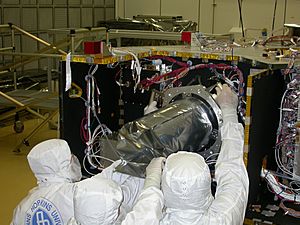
Many undergraduate students at Hopkins get to do important research. About 80% of them work on independent research projects, often with top researchers. In 2020, Johns Hopkins spent almost $3.1 billion on research. This is more than any other U.S. university for over 40 years in a row.
Many famous scientists and scholars have been part of Johns Hopkins. As of March 2025, 34 Nobel Prize winners have been connected to the university. This includes students, professors, or researchers. The most recent winners are Gregg Semenza and William G. Kaelin.
Between 1999 and 2009, Johns Hopkins was one of the most mentioned institutions in research papers worldwide. It was ranked third globally for the number of times its work was cited. In 2020, Johns Hopkins University was ranked 5th in the world for the number of new inventions (utility patents) it was granted.
In 2000, Johns Hopkins received $95.4 million in research grants from NASA. In 2002, Hopkins was the first university to spend over $1 billion on research in one year. In 2008, Johns Hopkins University spent $1.68 billion on science, medical, and engineering research. This made it the top U.S. academic institution for research spending for the 30th year in a row. These numbers include the work done at the Applied Physics Laboratory.
In 2013, the Bloomberg Distinguished Professorships program started with a $250 million gift from Michael Bloomberg. This program helps the university hire 50 top researchers from around the world. These professors work in different schools and research centers. They are leaders in research that combines different subjects and are active in teaching undergraduate students.
Research Centers and Institutes
University Divisions
|
Other Research Centers
|
Student Life at Johns Hopkins

| Race and ethnicity | Total | ||
|---|---|---|---|
| Asian | 27% |
|
|
| White | 26% |
|
|
| Hispanic | 17% |
|
|
| Foreign national | 12% |
|
|
| Other | 10% |
|
|
| Black | 8% |
|
|
| Economic diversity | |||
| Low-income | 18% |
|
|
| Affluent | 82% |
|
|
Charles Village, the area around the university, has been improved with new buildings. The university has bought property for more student housing. The "Charles Village Project," finished in 2008, added new shops and a modern residence hall. In 2015, the university started building more shops, restaurants, and apartments for older students.
Hopkins has also improved campus life with an arts center (the Mattin Center, built in 2001) and a sports facility (the O'Connor Recreation Center). The main dining halls were updated in 2006. The Mattin Center was taken down in 2021 to make way for a new Student Center, which is planned to open in fall 2024.
Students also enjoy being close to other schools like Loyola College and the Maryland Institute College of Art (MICA). They can also visit nearby neighborhoods like Hampden and the Inner Harbor.
Student Groups and Clubs
Johns Hopkins has many student organizations. Blue Jay Supper Society is an active secret society open to students and alumni.
Fraternity and Sorority Life
Fraternities and sororities came to Hopkins in 1876. As of spring 2025, Johns Hopkins has seven social fraternities and five social sororities. There are also ten culturally-based sororities and fraternities. Most fraternities have houses near campus, while sororities do not.
University Traditions
Johns Hopkins has some unique traditions. One popular myth is about the university seal in the Gilman Hall foyer. Students believe that if a current student steps on the seal, they will never graduate. Because of this, the seal is fenced off.
An annual winter event is the "Lighting of the Quads." During this ceremony, the campus is lit up with holiday lights. It often includes singing and fireworks.
The Spring Fair has been a Johns Hopkins tradition since 1972. It has grown to be the largest student-run festival in the country. It has carnival rides, vendors, food, and a beer garden.
Student Housing
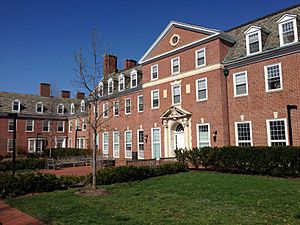
First- and second-year undergraduate students usually live on campus. Freshman housing is mostly in the Freshman Quad, which has three residence hall complexes. These include the Alumni Memorial Residences (AMR I and AMR II). Freshmen also live in Wolman Hall and parts of McCoy Hall. Dorms are generally co-ed with same-gender rooms. Since Fall 2014, students can choose to live in mixed-gender rooms.
Sophomores choose where they will live through a housing lottery. They live in McCoy Hall, the Bradford Apartments, the Homewood Apartments, or Scott-Bates Commons.
Most juniors and seniors move into apartments or row-houses nearby, often in the Charles Village community. About 45% of students live off-campus, and 55% live on campus.
Athletics and Sports
The university's sports teams are called the Johns Hopkins Blue Jays. The school colors for sports are spirit blue and black. Hopkins celebrates Homecoming in the spring, during lacrosse season. The men's and women's lacrosse teams play in NCAA Division I. Other teams play in NCAA Division III and are part of the Centennial Conference. The Lacrosse Museum and National Hall of Fame is also at JHU.
Men's Lacrosse Team
The school's most famous team is its men's lacrosse team. They have won 44 national titles. This includes nine NCAA Division I titles.
Hopkins's main lacrosse rivals are Princeton University, Syracuse University, and the University of Virginia. Their main rivals in Maryland are Loyola University Maryland, Towson University, the United States Naval Academy, and the University of Maryland. The rivalry with Maryland is the oldest.
In 2013, it was announced that the Blue Jays men's lacrosse team would join the Big Ten Conference starting in the 2015 season.
Women's Lacrosse Team
The women's lacrosse team is also part of the Big Ten Conference. They were ranked number 18 in 2015. In 2014, they finished the season with 15 wins and 5 losses. In 2015, it was announced that the Blue Jays women's lacrosse team would join the Big Ten Conference for the 2017 season.
Other Sports Teams
Hopkins has many strong Division III athletic teams. The Men's Swimming team won three straight NCAA Championships in 1977, 1978, and 1979. In 2009–2010, Hopkins won 8 Centennial Conference titles in various sports. The Women's Cross Country team was the first women's team at Hopkins to be ranked #1 nationally.
Hopkins has a good fencing team. They have been in the top three Division III teams in recent years. The men's swimming team has also ranked high in NCAA Division III. The water polo team was number one in Division III for several years.
The women's field hockey team has reached the NCAA semifinals for the last four seasons (2018, 2019, 2021, and 2022). They were the NCAA Division III National Championship runner-up in 2021 and 2022.
In 2022, the women's soccer team won their first NCAA Division III Women's Soccer National Championship. They had a season record of 23 wins, 0 losses, and 2 ties. This was the most wins in the program's history.
Famous People from Johns Hopkins
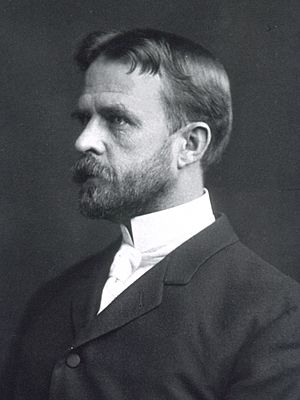

Many famous people have studied or worked at Johns Hopkins University. As of October 2019, this includes 29 Nobel laureates, 23 Rhodes Scholars, a Fields Medalist, a President of the United States, and 2 leaders of other countries.
Notable Alumni
Johns Hopkins was the first U.S. school based on the European research university model. Because of this, many alumni have become well-known in academics. These include biologist Thomas Hunt Morgan, who won a Nobel Prize for his work on heredity. Other famous alumni include philosopher John Dewey and Florence Bascom, the first woman to get a doctorate from Hopkins.
Many Hopkins alumni have become elected officials in the U.S. government. This includes current Representatives Lauren Underwood, Andy Harris, Sara Elfreth, and Kweisi Mfume. Three U.S. Senators also studied at Johns Hopkins.
At the state level, Governor of Maryland Wes Moore earned his BA in 2001. Former Baltimore Mayor Sheila Dixon also earned her master's degree from Hopkins.
Woodrow Wilson, the only U.S. President with a doctorate, received his Ph.D. from Johns Hopkins in 1890. Other alumni who served in high government positions include Secretary of War Newton D. Baker and Attorney General Benjamin Civiletti.
Since 1943, the Johns Hopkins School of Advanced International Studies has produced many important figures in U.S. diplomacy and security. This includes Madeleine Albright, the first woman to be U.S. Secretary of State.
In business, Hopkins alumni include Bloomberg, L.P. founder and former Mayor of New York City Mike Bloomberg. Other business leaders include Merrill Lynch co-founder Edmund C. Lynch and former IBM CEO Samuel J. Palmisano.
The Writing Seminars program has produced notable writers. These include Nigerian author Chimamanda Ngozi Adichie and Pulitzer Prize winners John Barth and Louise Erdrich. Journalist Iris Chang and jazz poet Gil Scott-Heron also attended.
In television and journalism, alumni include CNN anchor Wolf Blitzer and NBC News correspondent Hallie Jackson.
In arts and entertainment, famous alumni include actor John Astin and horror film director Wes Craven.
In sports, Johns Hopkins is known for its lacrosse tradition. Famous lacrosse figures include Dave Pietramala and Paul Rabil. Wes Unseld Jr., an NBA assistant coach, played college basketball at Hopkins.
Nobel Prize Winners
As of March 2025, 34 Nobel Prize winners have been connected to Johns Hopkins. This includes students, professors, or researchers. Woodrow Wilson, who earned his PhD from Johns Hopkins in 1886, was the university's first Nobel winner. He won the Nobel Peace Prize in 1919.
Eighteen Johns Hopkins affiliates have won the Nobel Prize in Physiology or Medicine. Four Nobel Prizes were shared by Johns Hopkins winners. For example, George Minot and George Whipple shared the 1934 Nobel Prize in Physiology or Medicine.
Four Johns Hopkins affiliates have won Nobel Prizes in Physics. These include James Franck in 1925 and Adam Riess in 2011.
Bloomberg Distinguished Professor Peter Agre won the 2003 Nobel Prize in Chemistry. Bloomberg Distinguished Professor Carol Greider won the 2009 Nobel Prize for Physiology or Medicine.
See also
 In Spanish: Universidad Johns Hopkins para niños
In Spanish: Universidad Johns Hopkins para niños




